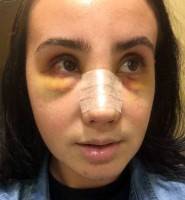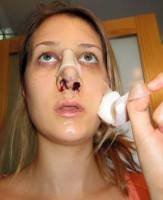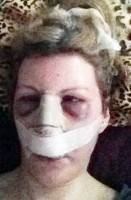Nose Job Swelling
The loss of swelling after a primary rhinoplasty happens in two phases.
The first phase is the first month after surgery. In this phase about 50% of the swelling subsides.
This includes the bruising and any skin discoloration that comes from the procedure. The second phase is month 2 through 12 in which the second 50% of swelling subsides.
This phase takes a long time as the skin on the nose softens and regains its normal thickness and texture.
The tip of the nose which is stiff and numb softens and regains sensation.
I typically follow patients for a full year to see complete resolution of the swelling. Swelling from secondary nose job (re-do operations) lasts even longer. Try to be patient. (Stephan Finical, MD, Charlotte Plastic Surgeon)
I generally let my patients know that they will be “restaurant ready” in 2 weeks meaning that if you were to have a dinner out, the people at the table next to you would not be looking at you thinking you had something done to your nose.
You may still have swelling that you notice, but other people probably won’t. The residual swelling slowly abates over the course of several months to a year.
The tip is usually the last area for the swelling to fully resolve.
Sometimes patients benefit from taping their noses at night to help minimize swelling over the dorsum and supratip. (Sirius K. Yoo, MD, San Diego Facial Plastic Surgeon)
Swelling after nose job
Acute swelling after nose job subsides within several weeks following surgery. After that it is common to have mild swelling in the nasal tip and above the tip of the nose (supra tip area).
Swelling in these areas, especially the supra tip area, takes much longer to fully subside (several months to many months). In some cases treatment of localized swelling above the tip of the nose will help to improve the final shape and outcome of the nose job procedure. (J. David Holcomb, MD, Sarasota Facial Plastic Surgeon)
Swelling after nose job varies greatly on what areas of the nose were treated. For the swelling to completely subside it takes about a year. To reduce swelling keep head elevated first two days after surgery and after that a gently massage nose. (Jaime Perez, MD, Tampa Plastic Surgeon)
It is not uncommon to have swelling for a considerable amount of time following nose job. The amount and duration of swelling depends on many factors: open vs. closed technique, bone reshaping, soft tissue thickness, skin thickness, and other issues.
In the early postoperative period, taping may be used to help control the swelling. Sleeping with the head slightly elevated can help as well. It takes time for all the swelling to go away so patience is necessary. (Christopher Khorsandi, MD, Las Vegas Plastic Surgeon)
Usually 2-3 weeks of major swelling, all swelling goes away by the end of the 9th month. Some patients may have residual swelling up to 12 months (Vartan Mardirossian, MD, Jupiter Facial Plastic Surgeon)
Nose swelling after nose job
I agree with the responses below. The nose may look good at 3-4 weeks, but still may have some swelling. the tip may remain swollen and somewhat firm for 3-6 months. That being said, the visual appearance should be quite good at 1-2 months, but firm to the touch for another few months. I hope that helps. (Paul E. Chasan, MD, Del Mar Plastic Surgeon)
The length of time for swelling after nose job is a very commonly asked question. The answer is a very common answer in plastic surgery – it depends. Typically, about 75% of swelling is gone after two weeks, especially in a person who follows the post operative instructions. At that point, the nose should look pretty normal to other people.
The patient and surgeon will probably continue to notice some swelling that will then gradually decrease over the next 6-12 months. It will be a slower process for the patient since he or she sees their nose every day.
The swelling will be increased if the skin of the tip is thick, and it may take longer before it looks ready. But for every single patient, if we take a photo at two weeks after surgery and again at one year, there will be a readily apparent difference. (Andrew Miller, MD, Edison Facial Plastic Surgeon)
Swelling After Rhinoplasty
In my expereience 80% of the swelling after rhinoplasty is better in 2-3 weeks, 90% after three months and the remining swelling can take up to a year to resolve.
Post op swelling of the tip takes the longest to resolve. Factors that contribute to longer swelling include: thicker skin, surgical approach and prior nasal surgery.
In certain situations the surgeon may consider a dilute steroid injection to help resistant swelling resolve more quickly.
Patience, however, is the key to dealing swelling after rhinoplasty. (Thomas E. Kaniff, MD, FACS, Sacramento Facial Plastic Surgeon)
More of a final result in the tip and midnasal area, definitely takes more than a year. One year will probably show 80-90% of the result in the tip and midnasal area.
Patients will return 2 , 3 , 4 years after rhinoplasty and still comment that their noses became thinner and tips more defined.
This is especially true in patients with thick skin. Asymmetries and imperfections may become more noticeable over the years.
That is why it is crucial to make sure the nose is as perfect as possible in the operating! (Vladimir Grigoryants, MD, Los Angeles Plastic Surgeon)
Postoperative Swelling After Rhinoplasty
Postoperative swelling can vary quite a bit depending on a host of factors. On average, at 3 weeks, swelling is still visible.
In general, I tell patients to expect a 70% reduction of swelling at 2 weeks, and an 80% reduction at 1 month. At 1 month, swelling is usually only noticeable to the surgeon and the patient and perhaps the patient’s closest friends and family members.
Other people who are unaware that the patient underwent surgery are unlikely to notice. The rest of the swelling usually dissipates after a year. Usually swelling in the tip is the last to resolve. Just a few of the factors that can affect swelling: skin type and thickness surgical approach (endonasal approaches that avoid the tip usually have less swelling) sun exposure and trauma extensive surgery (multiple grafts placed, revision surgery, multiple osteotomies).
I would also discuss your concerns with your surgeon who should be available to you for your postop needs. (Michael M. Kim, MD, Portland Facial Plastic Surgeon)
Rhinoplasty Swelling and Recovery
Factors involved in swelling include:
- how extensive was the surgery?;
- do you bruise and swell easily?;
- do you have thin or thick skin?;
- how much physical activity are you doing in the post-op period?
I tell my patients that they will have “good nose days” and “bad nose days” for a couple months – meaning that, some days, the nose will be a bit more swollen than others.
It’s not entirely predictable, and something like eating a really salty meal could even affect your nose early on.
As a general rule, 80% of the swelling is gone by 3-4 weeks. The remaining 20%, however, can take months. (Evan Ransom, MD, Bay Area Facial Plastic Surgeon)
The initial swelling from Rhinoplasty should be gone at around 2 weeks, and fully resolved at around 2 months. However, you may not see the fully defined result for up to 6-12 months post surgery. (Jeffrey W. Hall, MD, Austin Plastic Surgeon)
After rhinoplasty surgery there are three phases of healing:
- Swelling – this is made up of the swelling caused by tissue trauma and any bruising surrounding the surgery (usually 1-3 weeks)
- Stiffness – this is where tissue repair and the work of healing is progressing with early healing, and then late remodeling of tissues (3 weeks to 1 year)
- Softening – the final surgical result is reached; but gradual changes continue over the course of your lifetime which can still effect the shape of your nose. (Edward Szachowicz, MD, PhD, Minneapolis Facial Plastic Surgeon)
Swelling after rhinoplasty varies from patient to patient. In general, most of the swelling should be gone in 2 or 3 months. However, many patients experience subtle changes for up to a year or more. Three weeks is still very early. If your nose is very swollen, however, that may be cause for concern. You should discuss your concerns with your surgeon. (Steven L. Ringler, MD, FACS, Grand Rapids Plastic Surgeon)
Although the majority of the swelling is gone just a month after the rhinoplasty, it takes at least a year for the swelling to completely resolve, especially at the tip. Certainly, there can be significant variations among patients as well. I always explain to patients that when the sensation is almost back to normal at the tip of the nose the swelling is also almost resolved. (W. Tracy Hankins, MD, Las Vegas Plastic Surgeon)
Swelling after nose reshaping
All parts of our bodies swell after surgery, but the nose can take longer than other areas to resolve. We worry about it even more since it is the center of our faces!
However, the initial swelling will start to come down quickly after the first few weeks, and the remaining 25% or so will gradually improve over a year or more. I usually tell patients that they will see a difference right after surgery, but their nose will continue to refine and improve as the year goes by.
It’s hard to be patient, but this is one time when both the patient and the doctor have to trust in the process. If the underlying structure looks right during surgery, we just have to wait for the skin to conform to it and lose all the excess fluid. Thick skin does not do this as quickly or completely as thin skin. (Michelle Spring, MD, Missoula Plastic Surgeon)
Recovery & Swelling from Rhinoplasty Can Take Up to Three to Four Months
Every patient has a different response to the trauma of surgery. Some people typically remain bruised and swollen longer than others. In general, a significant amount of the swelling should be gone after one week.
Usually at the end of one week, a person can tell a noticeable difference between the preoperative and postoperative appearance. The tip of the nose will maintain the swelling longer than the rest of the nose. Although approximately 80% of the swelling of the nose may be gone within the first two weeks, you should expect to see steady and small improvements over the next two to three months.
At three to four months after the rhinoplasty, the swelling should be gone completely. (John J. Edney, MD, Omaha Plastic Surgeon)
The swelling after rhinoplasty varies from patient to patient.
The swelling after rhinoplasty varies from patient to patient. In general, most of the swelling should be gone in 2 or 3 months. However, many patients experience subtle changes for a year or more.
Three weeks is still early. If the nose is very swollen, however, that may be cause for concern. Your surgeon should follow your progress carefully. Sometimes the swelling does not fully resolve. (Thomas A. Mustoe, MD, FACS, Chicago Plastic Surgeon)
Nasal swelling following rhinoplasty.
The degree of nasal swelling one experiences following rhinoplasty is determined by multiple factors: The inherent propensity to swell and bruise following surgery. This is unique to each individual and can vary widely from person to person. The amount of manipulation the tissue incurs during surgery.
More ’tissue trauma’ results in more swelling. Open versus closed rhinoplasty. It is generally accepted that open rhinoplasty is associated with greater tip swelling for a longer period of time.
Preoperative use of medications known to be associated with increased bleeding and bruising. Intraoperative and postoperative use of medications designed to decrease swelling such as adrenal corticosteroids (predNIsone).
Postoperative patient compliance with measures designed to decrease swelling such as icing and head elevation.
The swelling that occurs following nasal surgery is known as edema and is due to the accumulation of excess tissue fluid, primarily outside the tissue cells referred to as extracellular fluid. During the postoperative period swelling progresses as follows:
- Rhinoplasty swelling in 2-3 days. Swelling typically increases for 2 to 3 days following surgery and peaks on the second or third day.
- Rhinoplasty swelling in 2 weeks. After 2 to 3 days, the swelling begins to subside. It does so quickly at first and then much more gradually. By the end of 2 weeks approximately 75% of the swelling has resolved. There may still be a variable degree of bruising. At this point one can go out into public without drawing significant attention to their nose.
- Rhinoplasty swelling in 3 months. At this point approximately 90% of the swelling has resolved. Going forward the nasal soft tissues will undergo change as the result of biologic remodeling in addition to resorption of edema (tissue fluid). Cartilage warping can also become apparent at this time. In general the changes that occur after this point will not enhance the cosmetic outcome and one can safely determine if a revision will be necessary. However, it is best to wait 1 full year to allow all of the healing to finish and associated changes to appear.
- Rhinoplasty swelling in 1 year. By this time the healing following the acute phase after surgery has finished and essentially 100% of the swelling due to post-surgical edema has resolved. Changes can occur beyond this point for several years.
Such changes, however, are not related to further resolution of edema but instead to one or more of the following:
- Soft tissue remodeling.
- Excessive soft tissue scarring.
- Cartilage warping.
- Collapse due to soft tissue scarring or gravity overpowering inadequate cartilage support not built into the nasal structure during the initial surgery. (Mario J. Imola, DDS, MD, Denver Facial Plastic Surgeon)
It is normal to have swelling three weeks after rhinoplasty, although this may be more evident to you than the general public.
Try not to over scrutinize your nose at this stage as it is still relatively early in the healing process.
There is good and bad with this after rhinoplasty swelling, It can hide subtle imperfections, which are not apparent until the swelling goes down, to some patient.’s disappointment.
It does also make the nose look larger, particularly the nasal tip from which location the selling usually resolves last. Sometimes, we will prescribe a short course of steroids to help hasten the resolution of this after rhinoplasty swelling. (Arthur N. Falk, MD, Albany Facial Plastic Surgeon)
Most of the major swelling can last 4-6 weeks. Subtle swelling can last a year or longer especially in the nasal tip area. (Rod J. Rohrich, MD, Dallas Plastic Surgeon)
Because of the nature of nasal tissue one can expect to have swelling for several months and sometimes for as long as a year or more.
It is usually acceptable for being in the public within 2 weeks postop. But swelling is the rule following rhinoplasty (Paul Vitenas, Jr., MD, West Palm Beach Plastic Surgeon)
After rhinoplasty swelling will depend on a number of factors including the surgeon’s technique, the type of procedure performed, and the patient’s healing ability.
At 3 weeks, you are still early in the healing process and this level of swelling will generally continue for another week. The nose may remain visibly swollen or puffy for 3 to 4 months.
Residual swelling resolves in one year. Patience and perseverance on your part is needed. (Kris M. Reddy, MD, FACS, Barrie Plastic Surgeon)
Swelling after rhinoplasty surgery
The time period of swelling after any surgery, let alone rhinoplasty surgery, of course, varies from person to person. Typically, the majority of swelling after rhinoplasty surgery subsides around 3 weeks after surgery. Bruising around the eyes and cheeks will usually subside after 7 to 10 days.
The residual swelling that persists after rhinoplasty surgery may take a year to a year and a half from the time of surgery. There is usually an associated stiffness, called induration, that will also resolve as swelling decreases. During this time period there are often some associated shape changes that also occur. (Michael A. Epstein, MD, Chicago Plastic Surgeon)
Swelling after Rhinoplasty. “Shrink-wrap phenomenon”
After rhinoplasty, the majority of visible swelling subsides in the first 2 weeks. However, it can take from 6 to 12 months for all of the minor swelling to resolve. Much of this has to do with the “shrink-wrap phenomenon” that occurs. The rhinoplasty procedure alters the bone and cartilage of the nose to create an aesthetically pleasing shape, whereas the skin of the nose is left untouched. Because the skin has “memory”, it takes a significant amount of time for the skin/outer structure to adhere to the new shape.
Think of it as shrink wrapping, which is the equivalent of the final rhinoplasty result, which as many other doctors above have pointed out, can take up to a year to fully produce its ultimate final shape. The role of the plastic surgeon therefore, does not end at the termination of the surgical procedure. Rather, it is imperative that the doctor-patient relationship continues throughout this prolonged recovery process in order to confirm that healing has occurred according to plan. (Matthew Kaufman, MD, Red Bank Plastic Surgeon)


